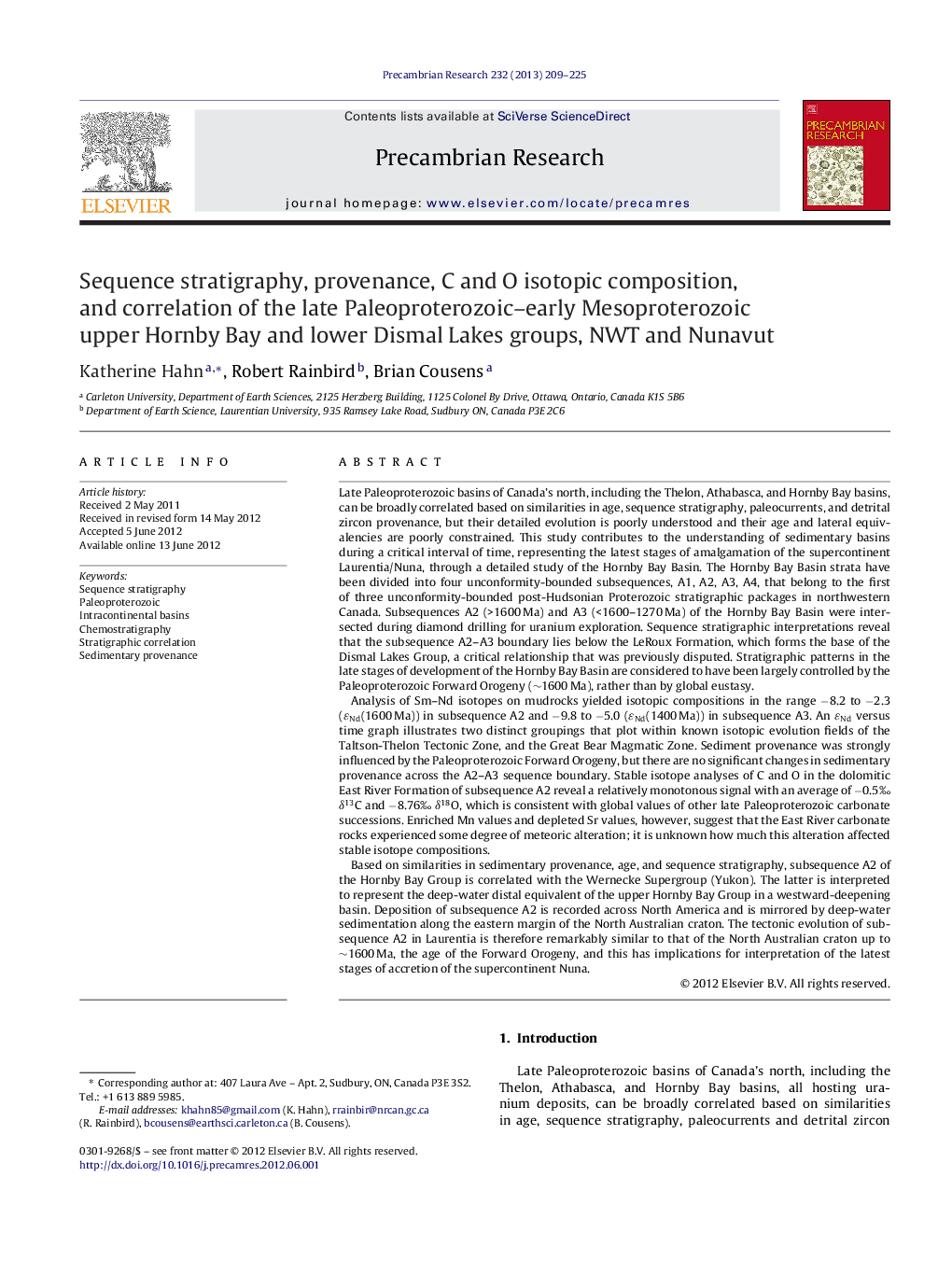| کد مقاله | کد نشریه | سال انتشار | مقاله انگلیسی | نسخه تمام متن |
|---|---|---|---|---|
| 4723121 | 1639642 | 2013 | 17 صفحه PDF | دانلود رایگان |

Late Paleoproterozoic basins of Canada's north, including the Thelon, Athabasca, and Hornby Bay basins, can be broadly correlated based on similarities in age, sequence stratigraphy, paleocurrents, and detrital zircon provenance, but their detailed evolution is poorly understood and their age and lateral equivalencies are poorly constrained. This study contributes to the understanding of sedimentary basins during a critical interval of time, representing the latest stages of amalgamation of the supercontinent Laurentia/Nuna, through a detailed study of the Hornby Bay Basin. The Hornby Bay Basin strata have been divided into four unconformity-bounded subsequences, A1, A2, A3, A4, that belong to the first of three unconformity-bounded post-Hudsonian Proterozoic stratigraphic packages in northwestern Canada. Subsequences A2 (>1600 Ma) and A3 (<1600–1270 Ma) of the Hornby Bay Basin were intersected during diamond drilling for uranium exploration. Sequence stratigraphic interpretations reveal that the subsequence A2–A3 boundary lies below the LeRoux Formation, which forms the base of the Dismal Lakes Group, a critical relationship that was previously disputed. Stratigraphic patterns in the late stages of development of the Hornby Bay Basin are considered to have been largely controlled by the Paleoproterozoic Forward Orogeny (∼1600 Ma), rather than by global eustasy.Analysis of Sm–Nd isotopes on mudrocks yielded isotopic compositions in the range −8.2 to −2.3 (ɛNd(1600 Ma)) in subsequence A2 and −9.8 to −5.0 (ɛNd(1400 Ma)) in subsequence A3. An ɛNd versus time graph illustrates two distinct groupings that plot within known isotopic evolution fields of the Taltson-Thelon Tectonic Zone, and the Great Bear Magmatic Zone. Sediment provenance was strongly influenced by the Paleoproterozoic Forward Orogeny, but there are no significant changes in sedimentary provenance across the A2–A3 sequence boundary. Stable isotope analyses of C and O in the dolomitic East River Formation of subsequence A2 reveal a relatively monotonous signal with an average of −0.5‰ δ13C and −8.76‰ δ18O, which is consistent with global values of other late Paleoproterozoic carbonate successions. Enriched Mn values and depleted Sr values, however, suggest that the East River carbonate rocks experienced some degree of meteoric alteration; it is unknown how much this alteration affected stable isotope compositions.Based on similarities in sedimentary provenance, age, and sequence stratigraphy, subsequence A2 of the Hornby Bay Group is correlated with the Wernecke Supergroup (Yukon). The latter is interpreted to represent the deep-water distal equivalent of the upper Hornby Bay Group in a westward-deepening basin. Deposition of subsequence A2 is recorded across North America and is mirrored by deep-water sedimentation along the eastern margin of the North Australian craton. The tectonic evolution of subsequence A2 in Laurentia is therefore remarkably similar to that of the North Australian craton up to ∼1600 Ma, the age of the Forward Orogeny, and this has implications for interpretation of the latest stages of accretion of the supercontinent Nuna.
Journal: Precambrian Research - Volume 232, July 2013, Pages 209–225